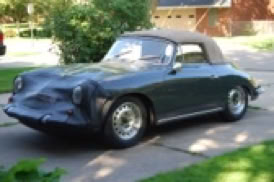
TITLE Destination 901
AUTHOR Weidenhammer, Peter
ENGLISH
ISBN 10 No ISBN 10
ISBN 13 9783613321625
Price $135.00

With Destination 901 Porsche has produced a truly significant book – nothing less than the process leading to the creation of the 901/911. While those who have read the 4 th edition of Excellence Was Expected know that it was not a straight-forward generation; Destination 901 not only tracks the development but provides the chart showing the interrelationships of the 644-T5/T6 and the T7, T8and T9. Unexpectedly it was the T9 4-passenger model which was cut. The book starts off with a multi-page explanation of why a 4 passenger type 530 didn’t work. He should have saved paper: It was dumpy.
Something I have never seen previously are 24 “protagonists” – the significant players at Porsche including biographies and what part each played. Unfortunately with Herbert Lang’s death since publication, none are still alive.
Factory photos abound although many are of 356 manufacturing, while implying they are of the 901. Additionally are notes, meeting minutes, memos – most in German but some actually translated or at least summarized.
Chapter one traces the evolution of 356 to the 901 from the 695, F.A. Porsche’s body complete with trailing arm front suspension, swing axel rear and 616 engine, step by step to the final 901. Not so incidentally, prior to the 901,
Porsches were Porsches; not until the 901 was the number 356 used. Hence what we call the 356C T6 was in the day a 644-T6. Superimposed factory schematics contrast “vast differences” between the visually similar 695 and
longer 754s. From the beginning a cabriolet had been planned, but fell by the wayside due to time and financial constraints – years prior to Ralph Nader’s Unsafe at any Speed and the US government’s interest in roll-over safety.
Chapter 2 Engine. It had always been a mystery to me why Porsche even considered its starting engine design. The 745 was a pushrod engine with camshafts above and below, side mounted carburetors and two small cooling
fans. It was designed to be a low as possible with a trunk above it. Storage space was at a premium with back seat occupying the previous storage. Quickly realized as soon as driven, the Typ 745 engine sounded like a thrasher, did not achieve planned horse power and had no scope for competition. Via overhead cams, dry sump lubrication and a single axial fan the development of the 821 hence 901 were developed.
Chapter 3, Chassis Development, final chapter, traces the ever increasing wheelbase until Ferry Porsche killed the Typ 9 four passenger and fell back on the Typ 8, originally co-developed as a junior entry level model with fast back –mistranslated as a hatchback. Starting with a complete 356 suspension -- the trailing arm front suspension evolved via a twin wishbone front suspension (not enough trunk space), an actual Mercedes strut suspension to the Porsche strut with torsion bars. The rear swing arm suspension could not be replaced by wishbones (due to engine interference); evolving to a semi-trailing arm suspension. Each of these possibilities was actually tried on the prototypes. August Acheitner evaluates the suspension decisions and why Porsche’s annular
disk brakes were not used – a discussion you will find no where else.
The translation is troubled by “moulds” rather than dies or pressed and “variable cam timing” when I suppose throttle is meant. Only here you find the family tree evolution from the 356 to 901 via 530, 633, 644 (T1, T2, T3, T4, T5, T6. T8), 656, 695, 754 (T7, T9) to the 901.
This book is absolutely required in any library of anyone interested in the Porsche’s move from the 356 to the 911 – arguably the most significant development in Porsche’s history.

